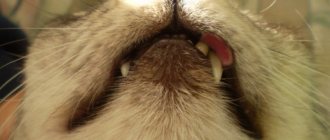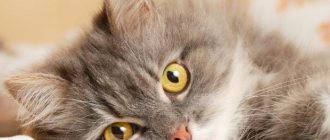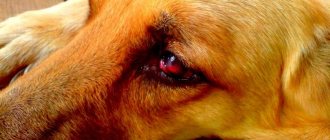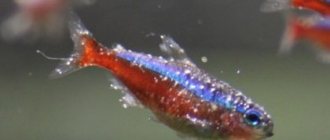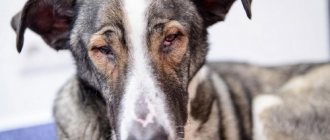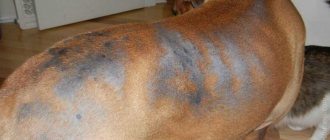Does our French Bulldog puppy suddenly have red eyes? Is this a pathology or not? Should you take your dog to the vet?
If the puppy is cheerful, plays actively and does not complain about appetite, there is no problem, and you can wait until you visit the doctor. The redness of the whites could have occurred because the wind blew up the convex surface of the eyes during a walk. Another reason for redness is that while swimming, a little shampoo may have gotten onto the mucous membrane. In addition, your puppy may have suffered microtrauma from dust getting into his eyes, or he may have had a minor allergic reaction.
You need to sound the alarm when redness is accompanied by a change in behavior and condition. For example, if the puppy has become lethargic, refuses to eat, his eyelids are red, his temperature has risen, he tries to scratch his eyes, shakes his head, or various discharges, inflammations, etc. have appeared in his eyes. If this is the case, then take your dog to a doctor and carefully follow his treatment recommendations. Apply the drops prescribed by the veterinarian and wipe the puppy's eyes with gauze swabs soaked in a decoction of sage or chamomile.
If everything else is fine, then, as Irina noted, most likely there is nothing serious and it will pass in a day or two.
The French Bulldog breed is susceptible to eye diseases, and their treatment requires immediate action. Otherwise, the disease will become chronic and may even lead to blindness.
The eyes of a French bulldog are the decoration of the breed. The standard requires that they be
- widely spaced
- slightly convex,
- had a beautiful round shape, dark color and black eyelids.
- When the dog is looking straight, the eyeballs should not be visible.
However, these attractive features make the dog vulnerable to various injuries and inflammations. While walking, sand and dust easily get into her eyes; she can damage them with blades of grass or bush branches; even strong winds cause irritation. In this case, tearing may occur, and pus may accumulate in the corners of the eyes. Therefore, caring for the eyes of a French bulldog is one of the mandatory hygiene procedures. It is recommended to wipe them twice a week with a special lotion or a soft cloth moistened with chamomile infusion or weak tea. Under no circumstances should you use boric acid or strong tea for this purpose. When using cotton swabs, it is recommended to ensure that hairs of the cotton do not get into the animal’s eyes.
Why do French Bulldogs have red eyes?
Mechanical stress, the influence of chemical reagents at home and on a walk, as well as food allergies cause catarrhal conjunctivitis in a French bulldog. It can occur in one or both organs of vision of the animal and occurs in an acute inflammatory form - the eyes turn red and become very watery, the eyelashes stick together. In this case, it is necessary to regularly rinse with boiled water and limit walking to prevent negative environmental impacts.
If the inflammation continues to develop, the redness of the mucous membrane intensifies, the French Bulldog's eye discharge becomes purulent and thick, and the swelling does not allow the dog to open his eyelids. The animal behaves depressed and sad. This means that the disease has progressed to the next - purulent - form. At this stage, urgent consultation with a veterinarian and intensive treatment with special anti-inflammatory drugs and antibiotics are necessary:
- drops of albucid, chloramphenicol, sofradex;
- ointments: tetracycline, chlortetracycline, etazol;
- an innovative product - ophthalmic medicinal films made from a mixture of antibiotics;
In each specific case, the doctor prescribes the necessary drug complex and dosage. Medications are accompanied by rinsing with boiled water, weak solutions of celandine and novocaine. The inflammation causes itching, so sometimes you have to put a blocking collar on your dog to prevent his paw from reaching his muzzle.
If the eyes of a French bulldog at this stage of the disease are not given due attention or self-medication, it can go into the third stage - follicular. On the inner side of the third eyelid - the transparent film that protects the cornea - enlarged lymphatic follicles of a dark cherry color become visible. The disease is chronic and lasts for years, sometimes exacerbating and then fading.
Proper dog care and regular hygiene procedures will keep it healthy and allow the owner to avoid unnecessary worries.
Necessary prevention
Routine vaccination
To reduce the risk of most dangerous diseases in French bulldogs, they must be vaccinated on time. Timely vaccinations can protect your dog from diseases such as canine distemper (distemper), rabies, parainfluenza, trichophytosis, leptospirosis, hepatitis, and paraviral enteritis.
In order for vaccinations to help your pet, they must be carried out according to the following schedule:
- first vaccination – dog age: eight to nine weeks;
- second vaccination – dog age: twelve to thirteen weeks;
- third vaccination – dog age: thirty to thirty-first week;
- Rabies vaccination – dog age: no earlier than twelve months.
After the first three vaccinations, they must be repeated every year at the same time. All vaccinations must be done using the same drug, for example, Nobivak. Before each vaccination, the French Bulldog must be dewormed (deworming) two weeks before. For this purpose, you can use the drug "Drontal".
Before each vaccination, you need to check the physical condition of your pet - he must be absolutely healthy. Also, pregnant and lactating French Bulldog bitches should not be vaccinated.
Rabies vaccination should also be done every year, for example, using the drug Nobivak DHPPI+R+L.
Vitamin and mineral supplements
In addition to routine vaccinations, the French Bulldog needs to have a proper diet. If your pet eats ready-made food, then he needs to buy premium or super premium food. Unlike cheap food, they contain all the necessary ingredients for the normal development of a dog.
On the advice of a doctor, you can add calcium or phosphorus to your animal's food. For example, when changing teeth.
If a French bulldog eats natural products, then it needs to add natural vitamins and other vital substances to its food: microelements, biologically active substances.
Group A vitamins are found in apples and liver and are responsible for proper metabolism.
B vitamins are found in liver, fermented milk products, and yeast. They are also responsible for metabolism.
Vitamins of group C can be given in the form of liver and tomatoes. This group is responsible for the proper functioning of connective tissues and helps in the absorption of calcium.
Vitamins of group D are found in cottage cheese, cheese, olive and sunflower oils. Promotes the absorption of calcium and phosphorus.
Vitamins of group E contain vegetable oils, which are responsible for the metabolism of carbohydrates and help break down fats.
Vitamins of group K can be found in some herbs, for example in nettles and young dandelions. This group is responsible for blood clotting.
To prevent your French Bulldog from overdosing on vitamin and mineral supplements, you need to consult a veterinarian. Only a doctor, after examining the dog, will be able to select the required dose of nutrients according to the individual needs of the animal’s body.
Tell us if your dog has been sick and how you dealt with his illness.
What dog breeds have red eyes?
In nature, there is only one case when red white membranes of the eye are a physiological norm. Albinos have no coloring pigment and the capillaries in the eyes are visible through the depigmented integumentary tissues. In all other cases, various reasons lead to redness, which have varying degrees of danger for the animal.
Reasons why a dog's eyes are watery
Why do my dog's eyes water? This problem may be due to:
— getting dust, small debris, and various aerosols into the eyes;
- reaction to improper feeding, for example, to a large number of sweets;
- blockage of the tear duct;
- inflammation of the lacrimal sac.
Pay attention to the last 3 points. Doctor intervention is required.
Causes of hyperemia
Redness of the whites of the eyes can look completely different, and, therefore, the reasons that cause it can be different. Redness occurs as a result of a violation of the integrity of the capillaries of the eye and hemorrhage. Hemorrhages can be pinpoint; this pathology is often caused by eye injury or penetration of an infectious agent.
Hemorrhages in the eye can become a symptom of retinal detachment, which is caused by such severe pathologies as diabetes mellitus and high blood pressure. Limited redness of the eye can be caused by the appearance of a neoplasm or displacement of the lacrimal gland. If the redness completely covers the entire protein, then it can be assumed that the animal has conjunctivitis. But the causes of severe inflammation of the cornea are varied:
- infection caused by fungal or bacterial invasion; corneal injuries; allergic reaction; ophthalmological pathologies (keratitis, uveitis, glaucoma); turning of the eyelids.
In rare cases, the cause of corneal hyperemia may be a genetic predisposition or helminthiasis. Red eye syndrome is a sure sign of a head injury. In this case, there may be no visual signs, but if the dog behaves unusually - walks with its head down, refuses food, loss of coordination and tremors of the limbs are obvious, then you should immediately contact a veterinarian.
When to contact a specialist
The dog's eyes are watering. What to do if rinsing does not help? In some cases, a visit to a specialist cannot be avoided. Only professional help from a veterinarian will avoid serious problems and complications.
Contact your veterinarian if:
— the dog’s eyes are red and watery for several days, despite washing;
- thick discharge from the eyes;
- the discharge is not transparent, but green, brown or yellow;
- the dog experiences discomfort and tries to rub its eyes with its paws;
— the dog squints, blinks constantly, closes his eyes frequently;
- eyes are dull, matte, without shine;
— you notice that your pet’s vision has deteriorated.
These symptoms indicate that lacrimation is not caused by exposure to an irritant (dust, smoke, wind, etc.), but by the onset of the disease. Similar pathological phenomena can be caused by conjunctivitis, districhiasis, and plague. Only a veterinarian, after examining the animal, will be able to find out the exact cause of lacrimation and prescribe effective treatment.
Carefully follow your veterinarian's recommendations, dosage and treatment time. If you do not pay attention to the first symptoms of the disease in time and start its course, then the treatment will be more complex and lengthy, and your pet’s vision may be damaged forever.
Dangerous pathologies, the symptom of which is redness of the eyes
Damage to the sclera can result from:
- autoimmune diseases; violation of the blood clotting process; tumors, including malignant ones; formation of ulcers and perforation of the protein membrane.
Regardless of the reasons for the redness of the whites of the eyes, you should immediately seek help from an ophthalmologist. A seemingly harmless condition can be a manifestation of severe or fatal pathologies that need to be treated promptly. There are no general recommendations, since there are many reasons for redness. Only differential diagnosis will help establish the exact cause and develop a treatment regimen.
Allergy symptoms
Unlike a person, whose nasopharynx is the first to suffer from an allergy, a dog immediately reacts with the epidermis. Typical skin irritations include:
- redness and inflammation;
- continuous itching (the animal scratches the skin until it bleeds);
- the appearance of ulcers, blisters and bloody ulcers;
- getting wet (sweating) armpits;
- thinning and hair loss;
- unpleasant smell.
By the way, persistent ear infections are recognized as the most striking and sure symptom of dog allergies.
. Slightly less often, allergies interfere with the functioning of the digestive tract and even less often lead to swelling or bronchial asthma.
Sometimes the hypersensitivity of a French bulldog manifests itself as allergic enteritis with symptoms of food poisoning:
- frequent attacks of nausea and vomiting are complemented by foam/bile discharge from the mouth;
- flatulence increases: the dog often passes gas, the stomach swells and colic begins;
- mucus appears in the stool, and acute diarrhea leads to uncontrolled defecation, which happens right in the apartment.
The most extreme symptom of any allergy is anaphylactic shock. If measures are not taken, the dog will die.
First aid for red eyes
Immediately as soon as the pet owner notices the hyperemic protein, it is necessary to rinse the animal’s eyes with plenty of warm boiled water, apply tetracycline ointment behind the eyelid and put a special insulating collar on the animal to avoid scratching and further injury.
Self-treatment of an animal with hormonal, anti-allergenic or vasoconstrictor agents is unacceptable. In some diseases, they can aggravate the dog's condition and lead to complete loss of vision. Before visiting the veterinary clinic, you can apply drops of “Diamond Eyes”, “Natural Tear” drops to the dog’s eyes - if the redness is not very pronounced and there is no discharge, or the drug “Tsiprovet” - for intense hyperemia.
All measures taken do not exclude a visit to a specialist, since some diseases are characterized by an undulating course and a tendency to relapse. Before visiting the clinic, you need to remember what events could lead to pathology - this is important for collecting anamnesis. To prevent the whites of the dog’s eyes from turning red, it is necessary to carefully monitor the pet’s hygiene, its state of health, and to prevent injury.
Eye injuries
Eye injuries are not uncommon in active dogs. A penetrating wound can occur as a result of a fight with another dog or cat, the dog can stumble upon a protruding branch or cut itself on the grass. Such damage may not be noticeable at first - a small dent remains on the eyeball. Then the eye begins to become inflamed, cloudy, and swollen. The dog cannot open it, there is lacrimation and suppuration. This situation is very dangerous!
You cannot help the dog on your own; you need an immediate consultation with a veterinarian - an ophthalmologist or a general practitioner. What should you do before visiting the vet? The most important thing is to not let your dog scratch its eye. In order to reduce pain, instill a solution of novocaine (2%). If it is not possible to contact a veterinarian immediately, then apply antibiotic drops to the eye. The listed measures are not treatment! If an eye injury occurs, you must contact a veterinarian as soon as possible (within 24 hours) and follow all his instructions, otherwise the animal will lose its vision.
Eye care rules
Normal vision in French bulldog puppies develops by the age of one and a half months, when they begin to distinguish objects well, navigate in space and follow moving objects.
However, unfortunately, over time, the “French” develop myopia . This happens closer to a year. It is important for the owner not to aggravate this process with poor visual care and not to speed it up due to oversights in the pet’s health.
A healthy dog's eyes are shiny but not watery. But when walking or being in dusty rooms, particles of dust, dirt, or small fragments of foreign objects or bodies may get into your eyes. Because of this, small clots of purulent discharge accumulate in the corners of the eyes.
Therefore, after walks, as well as in other cases, when this discharge appears, it is necessary to clean the dog’s eyes with a piece of clean cotton cloth or a napkin, removing this particular clot.
Important! Cotton wool can leave fibers in the eye, so its use is not advisable.
Discharge from the eyes may turn the color of the fur underneath pinkish-brown or coat that fur with a brown, sticky substance. This exudate in itself is not dangerous, but the color of the coat indicates the action of bacteria and yeast. Therefore, for a healthy dog, it is enough to wipe the eyes and fur underneath them every morning with a clean piece of cotton cloth or a napkin soaked in warm, clean water.
Red and watery eyes
Redness and tearing of the eyes can be caused by 3 reasons.
- Infection.
- Injury.
- Progressive disease.
When an infection occurs, the dog whines, rubs its eyes with its paws, blinks and worries for no reason. In this case, you need to carefully rinse your eyes. If this does not help, then the next cause may be injury. A characteristic sign is a bruise in the eye. The most difficult to visually identify are progressive diseases: retinal detachment and cataracts. At a late stage it is expressed in white and cloudy membranes of the eye.
An advanced infection can deprive a dog of his vision.
Causes of a runny nose
The manifestation of a runny nose in a “Frenchman” can occur in acute or chronic form. In acute rhinitis, treatment should be prescribed by a doctor. In this case, you need to start doing this immediately to avoid the disease becoming chronic. The main symptoms of the onset of the disease:
- The dog often sneezes, sniffles, and appears short of breath.
- Redness of the mucous membrane and eyes.
- Strong discharge from the nose, snot is initially liquid and transparent, then becomes thicker.
- Loss of appetite, up to complete refusal.
The main causes of rhinitis in dogs are:
- Allergies to animal care products, as well as pollen, dust and mold. Causes copious clear nasal discharge.
- Adenovirus infection is a disease caused by a virus of the Adenovirus family. Characterized by inflammation of the mucous membranes of the respiratory tract. Accompanied by swelling of the mucous membrane, wheezing, diarrhea and vomiting, and fever.
- Contact with the mucous membrane of various synthetic irritants, household and other chemicals. Characterized by sneezing and scratching the nose.
- Foreign objects entering the nasopharynx.
- The presence of polyps and tumors in the nasopharynx.
The sooner you contact a veterinarian, the easier the disease will progress. The doctor takes tests from the dog and makes an accurate diagnosis. Treatment for a runny nose involves taking antibiotics and medications to support the immune system. During this period, it is necessary to limit contact with other animals and ensure that the animal does not have an allergic reaction to medications.
A completely healthy French Bulldog should breathe almost silently or with a slight snore. This is considered normal and is not a cause for concern. The reason for this peculiarity of the respiratory system lies in the presence of a dog with a large head and a flattened muzzle. Pathology can be expressed in constant wheezing, grunting and whistling of the dog. These signs indicate an abnormally shaped dog's nasal septum or the onset of brachycephalic syndrome.
An operation to correct the nose can be performed in a veterinary clinic, after which the dog’s condition improves significantly and it begins to breathe fully. It is necessary to protect your dog from heatstroke on hot days. Under no circumstances should you leave your dog in the car if the outside temperature is more than +25 °C.
If the owner was unable to protect the dog, and the first signs of overheating appeared (blue tongue and hoarse breathing), it is necessary to apply a cold compress to the head or pour cold water on it and immediately take it to a veterinary clinic. Unnaturally heavy and noisy breathing with an open mouth, copious sputum production may be signs of blockage of the larynx or trachea, narrowing of the nasal sinuses, or brachycephalic syndrome. Such symptoms require immediate surgical intervention.
Allergies in an English Bulldog
Depending on the cause of the allergy, the disease affects different organs. If an English Bulldog's allergies are caused by food, then you need to follow a special diet. Tests will show the allergen, and its elimination will alleviate the animal’s condition, but there are other nutritional rules that are very important.
You cannot feed your bulldog raw foods, sweets and bread. They can cause allergies and also increase the weight of the animal, which is very undesirable for this breed.
The cause of the disease can even be one’s own fur. Therefore, it is very important to take good care of it and periodically bathe your pet with special hypoallergenic products. The English Bulldog sheds all year round, so constantly changing its coat becomes a real challenge for its owners and itself.
When you are not sure that the cause of the disease is an allergy in an English bulldog, photos will help identify symptoms on the skin.
Allergies to dust, pollen and some types of plants are manifested by lacrimation and redness of the mucous membrane of the eye. You should wet clean the house more often and ventilate the room, this will help clear the air of allergens.
Health problems in dogs of this breed
Depending on the characteristics of the morphological structure and physiology, the following pathologies appear in French bulldogs:
- diseases of the organs of vision;
- lesions of the osteochondral system;
- dermatological diseases;
- allergy;
- damage to the respiratory system;
- dental diseases.
Eye diseases
The wide open eyes of dogs protrude ⅓ beyond the bones of the skull. Despite the large viewing angle, they are easy to injure. When the eyeball is injured, clouding of the cornea , lens or vitreous body begins.
In most cases, the damaged organ cannot function normally, which leads to partial blindness. With a small wound, pathogenic microorganisms can enter the eye. In a humid environment, they begin to multiply quickly, causing suppuration and sepsis. Antibiotics can prevent the progression of pathology.
Due to the convex structure of the eyeballs, the mucous membranes protrude outward. When they become infected, conjunctivitis occurs. The development of the disease can be suspected if the dog’s whites are red, pus is discharged in the morning, or the eyelids are swollen. To treat the disease, eye drops for animals are necessary .
Important! If a bacterial infection occurs, it is necessary to take the bulldog to a veterinarian, who will conduct tests, determine the type of microorganism and prescribe drug therapy. Self-treatment is strictly prohibited.
Rarely, dogs experience third eyelid prolapse . You can fill the rudiment with your own hands or use the help of a surgeon. It is impossible to leave the situation uncontrolled in order to avoid the development of conjunctivitis and sepsis.
Skin
The pathological process develops in the area of the folds, where fluid and sebum accumulate. As a result of constant compression, the stratum corneum of cells cannot renew itself, so such areas require additional care. When a large number of dead epithelial cells accumulate, the work of the sweat and sebaceous glands is disrupted, and active secretion production begins.
The accumulation of sweat with sebum leads to irritation of the delicate dermis, causing dermatitis. The dog is constantly itching and feeling discomfort . To avoid the development of the disease, you should massage the folds, wipe the skin between them with dry wipes and bathe your pet in a timely manner.
French Bulldogs have delicate paw pads, especially in the nail growth area. They are easily damaged by sharp objects. An infection can get into the wound, which over time will cause inflammation and suppuration. Damage is indicated by lameness - dogs try not to lean on their wounded paws.
Reference! Dermatitis develops mainly in bulldogs in the area of white spots on the coat.
Allergy: causes, signs and its treatment
Strong allergens can provoke an inadequate immune response:
- poor quality or expired food;
- plant pollen;
- volatile substances in aerosols: fragrances, hairsprays, sprays;
- dust;
- synthetic products in the home: rubber, paints, furniture varnish;
- insect venom after a bite;
- some medications for individual intolerance in your pet.
An allergic reaction can be congenital and inherited . In some cases, against a background of weakened immunity, pathology may appear suddenly. In the latter case, the dog often finds itself in an unfavorable environmental situation. The allergy manifests itself as the pet begins to itch very much, hair falls out, inflammation, rashes and redness appear on the skin.
To avoid reactions, veterinarians recommend giving the animal 1 type of food. You should not purchase products from another brand. When purchasing dry food, you should pay attention to the composition: the ingredients must be natural without chemical additives. How to treat allergies in a pet? If you have allergies to pollen, dust or insect bites, you should take your dog to the veterinarian to prescribe antihistamines.
We invite you to watch a useful video about allergies in dogs using the example of a French bulldog:
Breathing problems
Bulldogs have a large skull and a short nose, which normally does not cause problems with the respiratory system. The young dog breathes calmly and does not make any extraneous sounds . At the same time, when aggression or another state of increased arousal occurs, the respiratory rate increases. As a result, you can hear characteristic wheezing.
With the development of the pathological process, the situation worsens with the development of brachiocephalic breathing. Problems with air flow into the lungs appear with age. Adults wheeze almost constantly, especially in hot and humid conditions.
Important! It is necessary to monitor the dog’s weight; you should not overfeed the bulldog. Obesity can lead to disruption of the respiratory system, followed by hypoxia.
With brachycephalic breathing, the pet opens its mouth and noisily inhales air. Hyperventilation of the lungs leads to the development of shortness of breath , the appearance of severe wheezing and growling. In some cases, sputum production increases. In addition, such symptoms develop when the tracheal tube is obstructed by the mucous membrane of the larynx or an elongated soft palate. Only surgical intervention can eliminate the violations.
A particular danger is stenosis of the nasal passage when the narrow nostrils are brought together. A thin septum and narrowed lumen of the nostrils slow down the flow of the required amount of air into the lungs.
Spinal diseases
Among lesions of the musculoskeletal system in French bulldogs, the 2 most common diseases of the spine are :
- osteochondrosis (discopathy) - degenerative-dystrophic changes in the structure of intervertebral discs;
- the appearance of wedge-shaped or hemivertebrae.
The latter pathology is a genetic feature and can therefore be transmitted to puppies. Occurs in small dogs with a curled tail. To treat osteochondrosis (discopathy) and remove an irregularly shaped vertebra, surgery is performed.
You should seek help from a veterinarian if you have scoliosis and if your hind legs weaken and fail.
Dental care
Every month you need to examine your pet's mouth. There should be no yellow plaque on the teeth - this is a sign of infection. Bacteria gradually thin the tooth enamel and lead to caries. To get rid of plaque, you should let your dog chew crackers or hard cookies. If the teeth cannot be cleaned on their own, you should purchase a special toothpaste for dogs and a toothbrush. Cleaning should be done at least 2 times a week.
Bulldogs can develop tartar, which causes bad breath. If dental disease has led to gum inflammation, you should seek help from a veterinarian. To suppress the growth and development of the pathological process, before visiting a specialist, you should wipe the affected tissue with a solution of potassium permanganate.
Causes of hind leg failure
Owners often go to the doctor with neurological problems - the back legs of a French bulldog are failing.
In this situation:
- strange movements are characteristic;
- there is weakness of the hind limbs;
- paralysis progresses.
There are many reasons why a French bulldog's hind legs may fail.
Most often this occurs due to injuries received: bruises, tendon ruptures, fractures.
They can also be a consequence of such diseases: tumors, arthritis, discopathy.
In most cases, the French Bulldog's hind legs are injured when falling, attacking, or severely biting another dog.
Let's take a closer look at the disease discopathy, which is typical for this breed of dog. It is dangerous because it occurs before the initial symptoms appear .
As the disease progresses, the pet may be passive but react strongly when touched on the back.
At the first changes in the dog’s behavior, or some oddities, it is worth consulting with specialists.
If time is lost, the bulldog's hind legs may fail without the possibility of cure.
There are both medical and surgical treatments for this disease.
To prevent this disease, before the age of seven months, it is necessary to exclude falls from any height, and one should not allow him to go down stairs.





